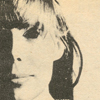The perpetual struggle of entertainment and sports promoters is to get enough paid bums into seats to cover the bills and to turn a small profit. Entertainment producers generally budget generous amounts to adverting and other promotional efforts to convince the public that a show is worth both their time and money. The ad budget and the design of the promotion campaign are determined by the type and size of the production, the anticipated drawing power of the show and its stars, and the number of scheduled performances. Promoters of hockey, baseball and football teams are challenged to sell tickets not to a single event but to a whole season of games.
During the settlement era most entertainments were the efforts of local amateurs presented to small communities hungry for entertainment. The participants in local sporting events were similarly well known local amateurs. Under these circumstances the simple typeset posters available from the newspaper print shop were probably sufficient to attract a good audience.
As prairie cities grew in size and as transportation links improved, they began to attract many touring American and British stock theatre, opera and vaudeville companies. A much more determined promotional effort was needed to cover the cost of large casts of touring professionals and the rent of 800+ seat theatres. Early entertainment promoters depended on the intensive postering of key areas of the city, advance notices in the theatre’s program, and display ads placed in the local dailies. There was the hope and expectation that newspapers would return the purchase of the ad with interviews, feature stories and reviews that might boost attendance.![Dance Coming! in Person . America's Dynamic Saxophonist-Entertainer His Excellency King Perry. [between 1944 and 1958].](entertainment/images/24932-small.jpg)
Eye grabbing street posters are still vital in the promotion of local performers and productions. They are cheap to produce and can be posted at little cost. Posters can be designed to accommodate the addition of separate dates and venue information if the act is touring.
Display ads in daily newspapers may be beyond the budget of new or emerging musicians and others performing to smaller audiences. Newspaper dailies do attempt to attract entertainment advertisements with reduced rates for repeated placements of ads, and by slotting them next to entertainment features. Free distribution weeklies focusing on youth and urban professionals, as well as university newspapers are now the medium of choice for many music, theatre and film promoters.
 Large ticket sales are essential to professional sports teams. The size of venues and the potential fan base is large enough to make radio and television adverting cost effective for many sports. The sale of season and repeat tickets depends upon a close identification of the fans with the team and the achievements and personalities of its star players. Most professional sports teams produce glossy illustrated programs filled with ads for distribution at home games. Large ticket sales are essential to professional sports teams. The size of venues and the potential fan base is large enough to make radio and television adverting cost effective for many sports. The sale of season and repeat tickets depends upon a close identification of the fans with the team and the achievements and personalities of its star players. Most professional sports teams produce glossy illustrated programs filled with ads for distribution at home games.
The Entertainment Gallery has two sub-galleries. The Andrew King page highlights the work of Andrew King, who operated a show print shop in southern Saskatchewan from 1912 to 1958. Sask Film Posters presents some examples from the collection of Brock Silversides at the University of Saskatchewan Archives.
See additional examples of Saskatchewan Theatre Posters and Programs at:
/drama/posters.html
|






